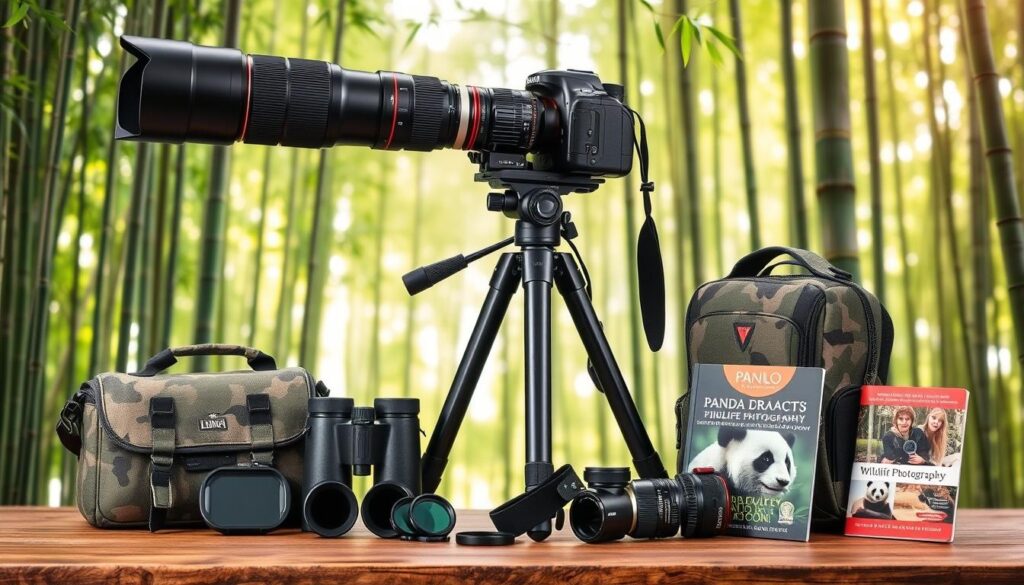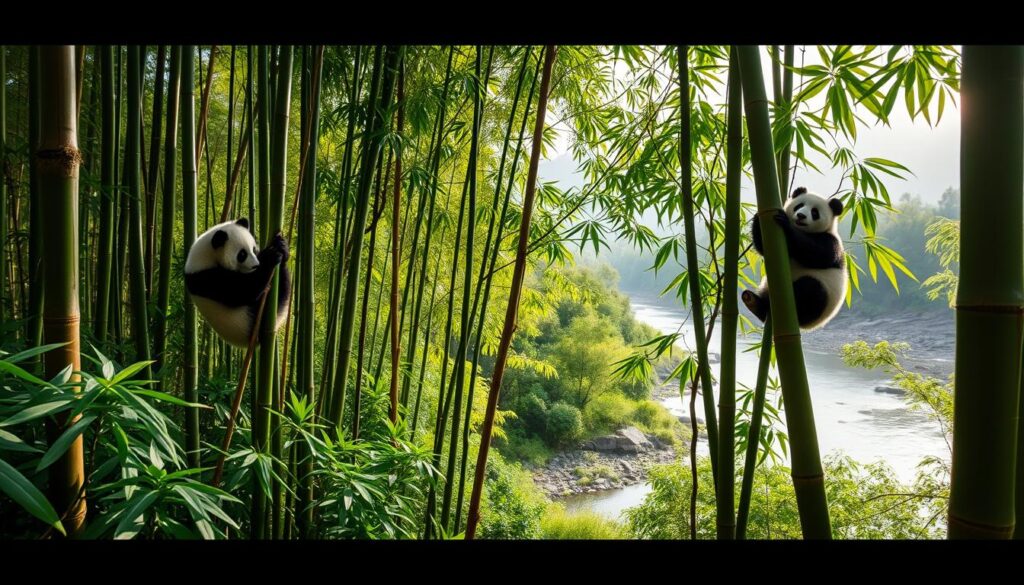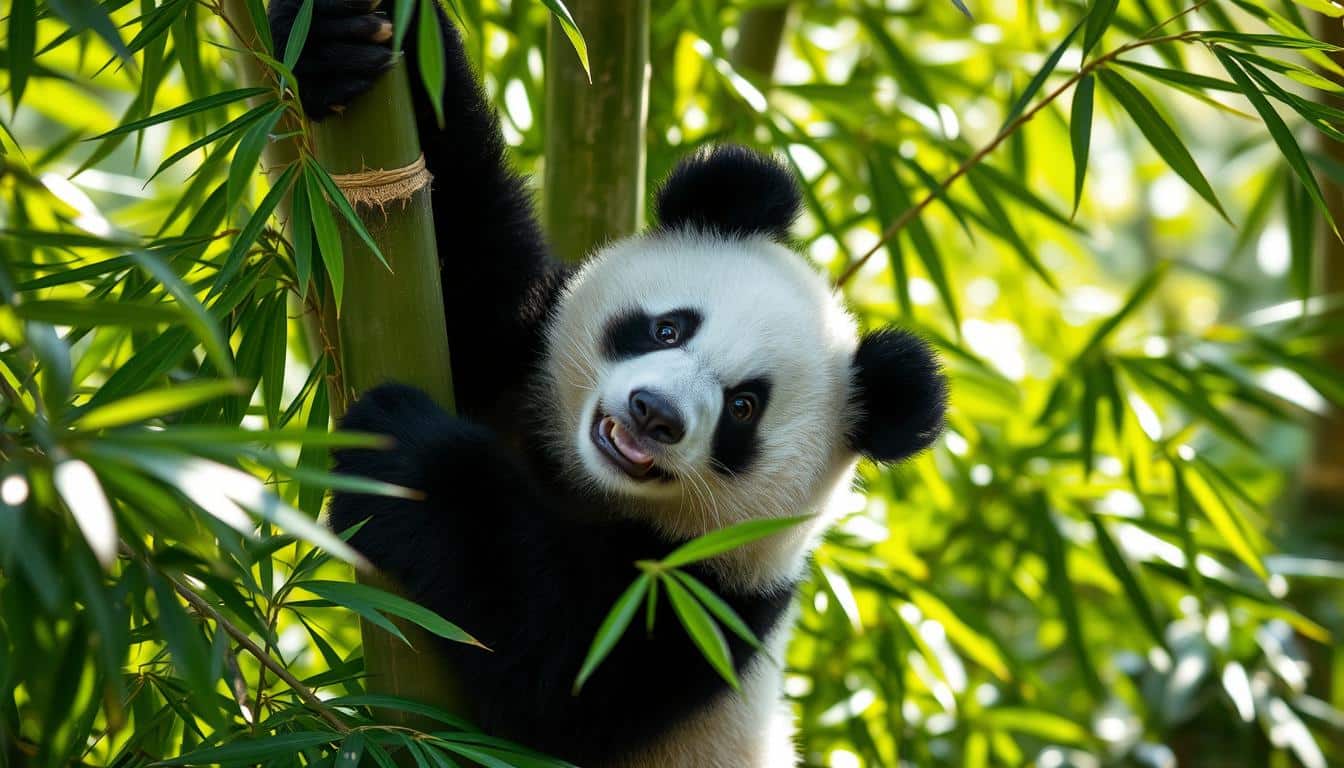The giant panda and the red panda are fascinating and hard to photograph. Panda Wildlife Photography Tips They live in bamboo forests in China, Nepal, and parts of India. To get great photos, you need the right gear and to know how pandas live.
This guide will help you improve your panda photography. We’ll talk about the best lenses, camera settings, and how to find pandas in the wild. It’s for both experienced and new photographers. You’ll learn how to capture the beauty of these rare animals.
Key Takeaways
- Panda behavior and habitats are crucial for successful wildlife photography
- Invest in the right gear, such as telephoto lenses and a sturdy tripod, for capturing panda images
- Adjust camera settings, including high ISO and auto-focus tracking, to account for low light conditions and fast-moving pandas
- Research and plan your panda photography trip to maximize your chances of encountering these elusive creatures
- Maintain a respectful distance from pandas to avoid disrupting their natural behaviors and habitats
Introduction to Panda Wildlife Photography
Pandas, both the giant panda and the red panda, are fascinating subjects for wildlife photography. They live in China’s mountains and have won the hearts of many. To take great photos of pandas, you need to know their behavior and where they live.
The Iconic Giant Panda of China
The giant panda is known worldwide for its black and white fur. These slow, bamboo-loving bears are rare, with only about 1,600 in the wild. Taking photos of them requires patience and care for their homes.
Understanding Panda Behavior and Habitats
The red panda also lives in the eastern Himalayas and southwestern China. These smaller, quicker pandas have their own ways of living and behaving. Photographers must explore their bamboo forests and mountains to get amazing shots.
“There could be an estimated 1,600 Pandas and 500 Siberian tigers living in the wild, making them some of the rarest and most endangered species on Earth.”
Conservation efforts for these pandas are vital. Groups like the World Wildlife Fund (WWF) help protect their homes and numbers. Wildlife photographers can help by sharing their photos and stories.
Essential Gear for Panda Photography

To take amazing panda photos, you need the right camera gear and accessories. The best lenses, cameras, tripods, and more can greatly improve your photos. They help with the quality and how your images look.
Choosing the Right Lenses and Cameras
For panda photos, a telephoto zoom lens like 70-200mm or 100-400mm on a full-frame camera is best. These lenses let you get close to pandas without scaring them. A wide aperture like f/3.2 or f/4 makes the background blurry and focuses on the panda.
In the low-light conditions of panda habitats, you might need a high ISO setting. This helps keep your shutter speed fast and prevents blurry photos.
Importance of Tripods and Monopods
A strong tripod or monopod is key for stability and sharp images, especially at slower shutter speeds. They help reduce camera shake and stabilize your camera. This makes your panda photos clear and sharp.
Having a second camera body is also useful. It lets you quickly switch between lenses and shots. This way, you can capture more wildlife photography views.
Camera Settings for Panda Photography

To get amazing panda photos, you need to think about your camera settings. Shooting in RAW is best because it lets you change many things later. This is very helpful in the tricky lighting of panda homes.
It’s also important to use your camera’s auto-focus well. Choose the right mode, like AI Servo AF or AF-C, to follow the pandas. Even though a low ISO is better, you might need a higher ISO in dark places. This helps you get a fast shutter speed to freeze the pandas’ quick moves. Paying attention to the exposure triangle (aperture, shutter speed, and ISO) is key for great panda photography.
Shooting in RAW for Maximum Flexibility
For panda photography, shooting in RAW is a good idea. It gives you more control and flexibility when editing. RAW files keep more data, so you can adjust things like exposure and white balance without losing quality.
Leveraging Auto Focus for Moving Subjects
Getting sharp photos of moving subjects like pandas is very important. Use the right auto-focus mode, like AI Servo AF or AF-C, to keep the pandas sharp. This way, you’ll get the best shot every time.
| Camera Setting | Recommended Value |
|---|---|
| Aperture | Wide open (e.g., f/2.8 to f/5.6) |
| Shutter Speed | 1/500s or faster |
| ISO | 200 to 1600 (adjust as needed) |
By adjusting these camera settings, you’ll be ready to take amazing panda photography. Your photos will show these beautiful animals in their natural home.
Panda Wildlife Photography Tips

To get the perfect panda photo, you need to do a lot of research and plan carefully. Before you go, find out the best places, the best times of year, and the best times of day. This will help you see these rare animals.
Researching and Planning Your Trip
It’s key to know how pandas behave and where they live. There are about 1,600 wild pandas, mostly in China’s Sichuan province. Look into places like the Wolong Panda Center and the Chengdu Panda Base to plan your trip well.
Maintaining Distance and Respecting Panda Habitats
When taking photos of pandas, keep a safe distance. This helps avoid disturbing them. It’s also important to respect their homes and the efforts to save them. Follow the rules and get advice from local experts for a good photo shoot.
“A significant percentage of panda bears still living are within some form of captivity.”
By planning well and keeping a safe distance, you can take amazing panda photos. This also helps protect these special animals. Remember, good panda photography is about more than just a great photo. It’s about caring for our planet and its creatures.
Best Locations for Panda Wildlife Photography

China’s Sichuan province is a top spot for panda photography. Places like Wolong Panda Center, Dujiangyan Panda Ark, and Chengdu Panda Base are famous. They give you great chances to take pictures of these cute animals.
Wolong Panda Center
The Wolong Panda Center is in the heart of the pandas’ home. It’s a great place to see and take photos of these amazing animals. The center helps protect pandas and shows visitors their daily lives.
Dujiangyan Panda Ark
The Dujiangyan Panda Ark is special because you can volunteer and get close to the pandas. It’s a great place for photos and helping protect these animals.
Chengdu Panda Base
The Chengdu Panda Base is huge and famous worldwide. It’s where many people come to see pandas up close. With over 261 pandas born here, it’s a top spot for panda photos.
Every place has its own photo opportunities. They vary in how easy they are to get to and how many people are there. Whether you’re a pro or just starting, these places in Sichuan, China, will give you amazing photos and memories.
Also Read : What Are The Unique Characteristics Of The Giant Panda?
Conclusion
To get the perfect panda photo, you need the right gear, camera settings, and knowledge of panda behavior. Invest in good telephoto lenses and sturdy tripods. Use RAW format and auto-focus to improve your shots. Also, do your research and plan well to respect panda habitats and conservation.
The world of panda wildlife photography is both exciting and challenging. It spans from China’s giant pandas to the red pandas in the eastern Himalayas. Photography can help raise awareness and support conservation efforts for these endangered animals.
Responsible photography practices are key. Respect panda habitats and support conservation groups. This way, photographers can help ensure the survival of pandas. Their work can inspire others to protect these animals and their habitats, leading to a better future.
FAQs
Q: What are some tips for photographing red pandas in their natural habitat?
A: To capture stunning photographs of red pandas, spend weeks searching in remote areas of Nepal or India where they reside. Early morning or late afternoon is best, as they are most active then. Use a lens in the 80-400mm range for better distance shots and ensure you adjust your exposure compensation to account for their reddish-brown fur against the green foliage.
Q: How can I improve my chances of spotting a red panda while trekking?
A: Red pandas are nocturnal and tend to stay hidden during the day. To improve your chances, trek in areas where they are known to mark their territory. Look for signs like paw prints or branches they might have moved. Joining guided tours can also help as they often know the best spots.
Q: Are there specific locations in Nepal or India that are best for panda photography?
A: Yes, areas such as the Makalu region in Nepal or certain wildlife reserves in India are great spots. These locations provide thick forest cover, which is the natural habitat for red pandas. Spending time in these regions increases your chances of getting the perfect photograph.
Q: What equipment should I bring for photographing red pandas?
A: A camera with a versatile lens, ideally within the 80-400mm range, is recommended for capturing wildlife from a distance. Additionally, bring a sturdy tripod for stability in low light and consider a flash for close-up shots, as red pandas can be quite shy and hard to find.
Q: Can I photograph red pandas at a zoo instead of in the wild?
A: Yes, photographing red pandas at a zoo can be an alternative if you cannot trek to their natural habitat. Zoos often have informative displays about panda conservation, and you can get closer shots without the need for extensive trekking. However, keep in mind that their behavior might differ from those in the wild.
Q: What should I know about panda conservation when photographing them?
A: It’s important to be aware of panda conservation efforts, as many species, including red pandas, are endangered due to habitat loss. Consider supporting organizations that work on conservation and educate others about the importance of protecting these beautiful creatures and their environments.
Q: What are some challenges of photographing pandas in the wild?
A: One of the main challenges is their elusive nature; red pandas are hard to find and often spend time high up in trees. They also blend into their surroundings due to their coloring. Weather conditions can also impact visibility and accessibility in remote areas. Patience and persistence are key.
Q: How can I make my panda photographs stand out?
A: To create unique photographs, focus on capturing their behavior, such as climbing or playing. Use a shallow depth of field to blur the background and highlight your subject. Additionally, try to capture them in their natural environment, showcasing their day-to-day lives and interactions with their surroundings.
Q: What time of day is best for photographing red pandas?
A: Late afternoon is usually the best time for photographing red pandas as they are more active then. The soft, warm light during this time can enhance the colors of their fur and add depth to your images. Early morning can also be a good option, but be prepared for cooler temperatures.

